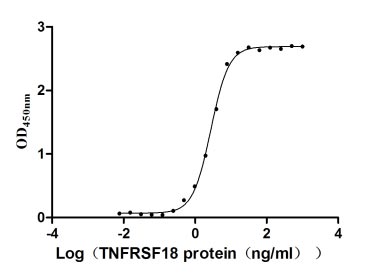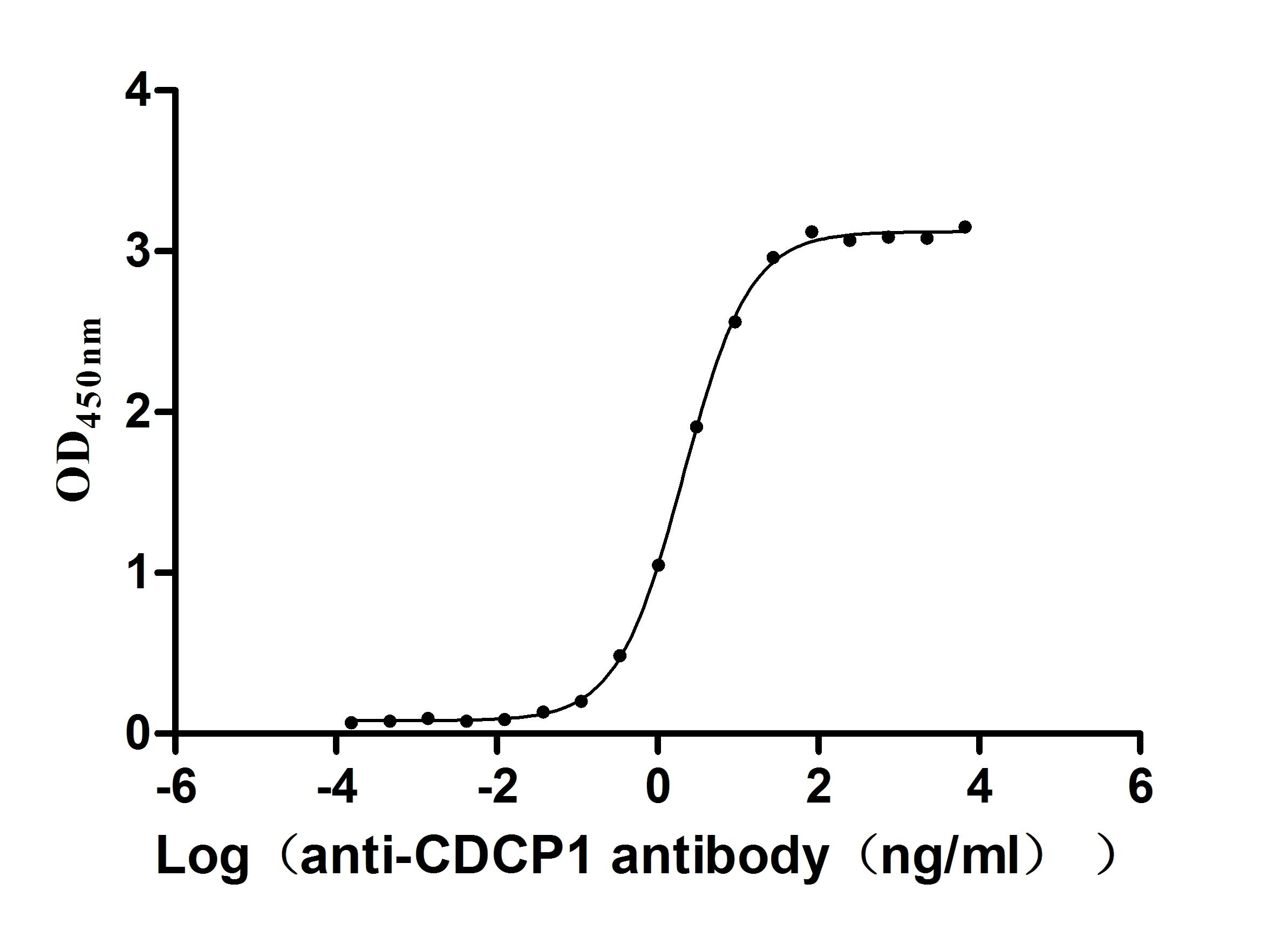Recombinant Mouse Cyclic AMP-dependent transcription factor ATF-5 (Atf5)
-
中文名称:Recombinant Mouse Cyclic AMP-dependent transcription factor ATF-5(Atf5),Yeast
-
货号:CSB-YP002276MO
-
规格:
-
来源:Yeast
-
其他:
-
中文名称:Recombinant Mouse Cyclic AMP-dependent transcription factor ATF-5(Atf5),Yeast
-
货号:CSB-EP002276MO-B
-
规格:
-
来源:E.coli
-
共轭:Avi-tag Biotinylated
E. coli biotin ligase (BirA) is highly specific in covalently attaching biotin to the 15 amino acid AviTag peptide. This recombinant protein was biotinylated in vivo by AviTag-BirA technology, which method is BriA catalyzes amide linkage between the biotin and the specific lysine of the AviTag.
-
其他:
-
中文名称:Recombinant Mouse Cyclic AMP-dependent transcription factor ATF-5(Atf5),Yeast
-
货号:CSB-BP002276MO
-
规格:
-
来源:Baculovirus
-
其他:
-
中文名称:Recombinant Mouse Cyclic AMP-dependent transcription factor ATF-5(Atf5),Yeast
-
货号:CSB-MP002276MO
-
规格:
-
来源:Mammalian cell
-
其他:
产品详情
-
纯度:>85% (SDS-PAGE)
-
基因名:Atf5
-
Uniprot No.:
-
别名:Atf5; Atfx; Nap1Cyclic AMP-dependent transcription factor ATF-5; cAMP-dependent transcription factor ATF-5; Activating transcription factor 5-alpha/beta; BZIP protein ATF7; NAP1; NRIF3-associated protein; Transcription factor ATFx; Transcription factor-like protein ODA-10
-
种属:Mus musculus (Mouse)
-
蛋白长度:Full length protein
-
表达区域:1-283
-
氨基酸序列MSLLATLGLE LDRALLPASG LGWLVDYGKL PLAPAPLGPY EVLGGALEGG LPGGGEPLAG DGFSDWMTER VDFTALLPLE APLPPGTLPP PSPAPPDLEA MASLLKKELE QMEDFFLDAP LLPPPSPPPP PPPAAAPSLP LPLPLPTFDL PQPPTLDTLD LLAVYCRSEA GPGDSGLSTL PVPQQPPPLA PLPSPARPAP YPSPASTRGD RKQKKRDQNK SAALRYRQRK RAEGEALEGE CQGLEARNRE LRERAESVER EIQYVKDLLI EVYKARSQRT RST
-
蛋白标签:Tag type will be determined during the manufacturing process.
The tag type will be determined during production process. If you have specified tag type, please tell us and we will develop the specified tag preferentially. -
产品提供形式:Lyophilized powder
Note: We will preferentially ship the format that we have in stock, however, if you have any special requirement for the format, please remark your requirement when placing the order, we will prepare according to your demand. -
复溶:We recommend that this vial be briefly centrifuged prior to opening to bring the contents to the bottom. Please reconstitute protein in deionized sterile water to a concentration of 0.1-1.0 mg/mL.We recommend to add 5-50% of glycerol (final concentration) and aliquot for long-term storage at -20℃/-80℃. Our default final concentration of glycerol is 50%. Customers could use it as reference.
-
储存条件:Store at -20°C/-80°C upon receipt, aliquoting is necessary for mutiple use. Avoid repeated freeze-thaw cycles.
-
保质期:The shelf life is related to many factors, storage state, buffer ingredients, storage temperature and the stability of the protein itself.
Generally, the shelf life of liquid form is 6 months at -20°C/-80°C. The shelf life of lyophilized form is 12 months at -20°C/-80°C. -
货期:Delivery time may differ from different purchasing way or location, please kindly consult your local distributors for specific delivery time.Note: All of our proteins are default shipped with normal blue ice packs, if you request to ship with dry ice, please communicate with us in advance and extra fees will be charged.
-
注意事项:Repeated freezing and thawing is not recommended. Store working aliquots at 4°C for up to one week.
-
Datasheet :Please contact us to get it.
相关产品
靶点详情
-
功能:Transcription factor that either stimulates or represses gene transcription through binding of different DNA regulatory elements such as cAMP response element (CRE) (consensus: 5'-GTGACGT[AC][AG]-3'), ATF5-specific response element (ARE) (consensus: 5'-C[CT]TCT[CT]CCTT[AT]-3') but also the amino acid response element (AARE), present in many viral and cellular promoters. Critically involved, often in a cell type-dependent manner, in cell survival, proliferation, and differentiation. Its transcriptional activity is enhanced by CCND3 and slightly i...显示更多
-
基因功能参考文献:
- Study reports that reduced levels of ATF5 in brain of Huntington's disease patients, probably due to its sequestration into the characteristic PolyQ containing neuronal inclusion bodies, correlates with decreased levels of the antiapoptotic protein MCL1, a transcriptional target of ATF5. Also provides evidence of decreased ATF5 being deleterious by rendering neurons more vulnerable to polyQ-induced apoptosis. PMID: 28861715
- Data indicate activating transcription factor 5 (ATF5) as a member of the transcriptional network governing pancreatic beta-cell survival during stress. PMID: 28115692
- ATF5 is one of the transcription factors crucial for the vomeronasal sensory formation. PMID: 26395637
- Atf5 is required for mouse olfactory bulb development via interneuron. PMID: 25704077
- Data indicate that downregulation of ATF5 inhibits adipogenesis through C/EBPalpha by impairing the interaction with p300-C/EBPbeta. PMID: 24216764
- Both ATF5 and CHOP have proapoptotic functions in mouse embryonic fibroblasts. PMID: 23761072
- Adult neurons express ATF5; its levels increase upon endoplasmic reticulum stress as a neuroprotective mechanism. PMID: 23518711
- ATF5 is required for terminal differentiation and survival of olfactory sensory neurons. PMID: 23090999
- BBF2H7-ATF5-MCL1 pathway specifically suppressed ER stress-induced apoptosis in chondrocytes. PMID: 22936798
- These findings indicate a reciprocal interaction between ATF5 and Shh in which Shh stimulates ATF5 expression and in which ATF5 contributes to Shh-stimulated cerebellar granule neuron progenitor cell expansion. PMID: 22095825
- Data show that transcription factor ATF5 is expressed in the postnatal brain. PMID: 21725368
- essential in malignant glioma genesis and ATF5-mediated survival pathway identified PMID: 20495567
- Inhibition of apoptosis by ATFx PMID: 12130540
- molecular cloning of two novel mRNAs, genomic organization, and odorant sensory neuron localization PMID: 12213205
- Data found that in Bmal1 -/- mice, the Atf5 expression could be regulated by CLOCK/brain and BMAL1 heterodimer by their binding to its E-box motif and repressing its promoter activity. PMID: 17823250
- ATF4 contributes to basal ATF5 transcription, and eIF2 kinases direct the translational expression of multiple transcription regulators by a mechanism involving delayed translation reinitiation PMID: 18195013
- The activating transcription factor 5 is a potent repressor of Tumor Suppressor Protein p53 and elevated expression of activating transcription factor 5 in a tumor. PMID: 19293535
- Fasting resulted in elevation of the expression of both Atf5 mRNA subtypes, Atf5-R1 and R2, in the liver. PMID: 19376136
- At the postnatal stage, Atf5 was expressed in epiphyseal chondrocytes and osteoblasts lining the bone trabeculae. PMID: 19712269
收起更多
-
亚细胞定位:Cytoplasm. Nucleus. Cytoplasm, cytoskeleton, microtubule organizing center, centrosome.
-
蛋白家族:BZIP family
-
组织特异性:Highly expressed in liver and at lower levels in heart, brain, lung, kidney, adipose tissue, and skeletal muscle. Expressed in some immature and in all mature olfactory sensory neurons (at protein level).
-
数据库链接:
KEGG: mmu:107503
STRING: 10090.ENSMUSP00000047771
UniGene: Mm.389890




















